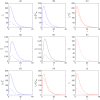Implication of vaccination against dengue for Zika outbreak
- PMID: 27774987
- PMCID: PMC5075941
- DOI: 10.1038/srep35623
Implication of vaccination against dengue for Zika outbreak
Abstract
Zika virus co-circulates with dengue in tropical and sub-tropical regions. Cases of co-infection by dengue and Zika have been reported, the implication of this co-infection for an integrated intervention program for controlling both dengue and Zika must be addressed urgently. Here, we formulate a mathematical model to describe the transmission dynamics of co-infection of dengue and Zika with particular focus on the effects of Zika outbreak by vaccination against dengue among human hosts. Our analysis determines specific conditions under which vaccination against dengue can significantly increase the Zika outbreak peak, and speed up the Zika outbreak peak timing. Our results call for further study about the co-infection to direct an integrated control to balance the benefits for dengue control and the damages of Zika outbreak.
Figures


 .
.
 are located in the red region while it can decrease the total number of Zika infections in the green region; (B) The relationship of the total number of Zika infections to the ratio
are located in the red region while it can decrease the total number of Zika infections in the green region; (B) The relationship of the total number of Zika infections to the ratio  with or without vaccination against dengue. Here, Pz = 0.3 and Pv = 0.7; (C) The relationship of ΔZ to the effective coverage rate of dengue vaccine Pv while the parameters Pz and
with or without vaccination against dengue. Here, Pz = 0.3 and Pv = 0.7; (C) The relationship of ΔZ to the effective coverage rate of dengue vaccine Pv while the parameters Pz and  are chosen in the red region of (A) with Pz = 0.3; (D) The relationship of ΔZ to the effective coverage rate of dengue vaccine Pv while the parameters Pz and
are chosen in the red region of (A) with Pz = 0.3; (D) The relationship of ΔZ to the effective coverage rate of dengue vaccine Pv while the parameters Pz and  are chosen in the green region of (A) with Pz = 0.3. Other parameters in (A–D) are fixed as Pd = 0.3, Pdz = 0.1, S0 = 100000.
are chosen in the green region of (A) with Pz = 0.3. Other parameters in (A–D) are fixed as Pd = 0.3, Pdz = 0.1, S0 = 100000.



 for (A) βdz = 0.05, βrz = 0.18, Λ = 10000 and (B) βdz = 0.05, βrz = 0.18, Λ = 1000000. The accumulated number of humans infected with Zika for (C) βdz = 0.18, βrz = 0.18, Λ = 10000 and (D) βdz = 0.18, βrz = 0.05, Λ = 10000.
for (A) βdz = 0.05, βrz = 0.18, Λ = 10000 and (B) βdz = 0.05, βrz = 0.18, Λ = 1000000. The accumulated number of humans infected with Zika for (C) βdz = 0.18, βrz = 0.18, Λ = 10000 and (D) βdz = 0.18, βrz = 0.05, Λ = 10000.Similar articles
-
A conceptual model for optimizing vaccine coverage to reduce vector-borne infections in the presence of antibody-dependent enhancement.Theor Biol Med Model. 2018 Sep 3;15(1):13. doi: 10.1186/s12976-018-0085-x. Theor Biol Med Model. 2018. PMID: 30173664 Free PMC article.
-
Impact of ADE and Dengue Vaccination with Screening on Cost and Disease Burden for Homoserotypic Dengue and Zika.Bull Math Biol. 2025 Apr 4;87(5):62. doi: 10.1007/s11538-025-01440-2. Bull Math Biol. 2025. PMID: 40183845
-
Human T cell responses to Dengue and Zika virus infection compared to Dengue/Zika coinfection.Immun Inflamm Dis. 2018 Jun;6(2):194-206. doi: 10.1002/iid3.203. Epub 2017 Dec 28. Immun Inflamm Dis. 2018. PMID: 29282904 Free PMC article.
-
Animal Models for Dengue and Zika Vaccine Development.Adv Exp Med Biol. 2018;1062:215-239. doi: 10.1007/978-981-10-8727-1_16. Adv Exp Med Biol. 2018. PMID: 29845536 Review.
-
[Zika virus: a public health overview on epidemiology, clinical practice and prevention].Ig Sanita Pubbl. 2016 Mar-Apr;72(2):161-80. Ig Sanita Pubbl. 2016. PMID: 27336960 Review. Italian.
Cited by
-
Modeling Lyme disease transmission.Infect Dis Model. 2017 May 19;2(2):229-243. doi: 10.1016/j.idm.2017.05.002. eCollection 2017 May. Infect Dis Model. 2017. PMID: 29928739 Free PMC article. Review.
-
A conceptual model for optimizing vaccine coverage to reduce vector-borne infections in the presence of antibody-dependent enhancement.Theor Biol Med Model. 2018 Sep 3;15(1):13. doi: 10.1186/s12976-018-0085-x. Theor Biol Med Model. 2018. PMID: 30173664 Free PMC article.
-
Exploring Zika's dynamics: A scoping review journey from epidemic to equations through mathematical modelling.Infect Dis Model. 2024 Dec 31;10(2):536-558. doi: 10.1016/j.idm.2024.12.016. eCollection 2025 Jun. Infect Dis Model. 2024. PMID: 39897087 Free PMC article. Review.
-
Game-Theoretical Model of the Voluntary Use of Insect Repellents to Prevent Zika Fever.Dyn Games Appl. 2022;12(1):133-146. doi: 10.1007/s13235-021-00418-8. Epub 2022 Jan 30. Dyn Games Appl. 2022. PMID: 35127230 Free PMC article.
-
Modelling the impact of antibody-dependent enhancement on disease severity of Zika virus and dengue virus sequential and co-infection.R Soc Open Sci. 2020 Apr 15;7(4):191749. doi: 10.1098/rsos.191749. eCollection 2020 Apr. R Soc Open Sci. 2020. PMID: 32431874 Free PMC article.
References
-
- Kautner I., Robinson M. J. & Kuhnle U. Dengue virus infection: Epidemiology, pathogenesis, clinical presentation, diagnosis, and prevention. J. Pediatr. 131, 516–524 (1997). - PubMed
-
- Halstead S. B. Dengue. The Lancet 370, 1644–1652 (2007). - PubMed
-
- Dick G. W., Kitchen S. F. & Haddow A. J. Zika virus (I). Isolations and serological specificity. Trans. R. Soc. Trop. Med. Hyg. 46, 509–520 (1952). - PubMed
Publication types
MeSH terms
LinkOut - more resources
Full Text Sources
Other Literature Sources
Medical
Miscellaneous

